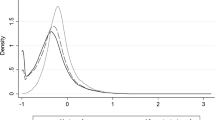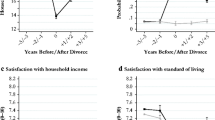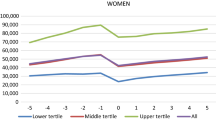Abstract
While the correlation between financial hardship and divorce is well-documented, the causality remains unclear: it is plausible that divorce causes hardship, that hardship encourages divorce, or that unobserved factors produce both outcomes. We specify a model that nests these possibilities and estimate it using the National Longitudinal Survey of Youth 1979. Structural estimates indicate divorce reduces the income/needs ratio in women’s households by 0.35 standard deviations, though this is partially offset by apparent anticipatory labor supply responses. We also find a negative structural error correlation between divorce and income/needs ratios, but no evidence that a change in hardship causes divorce.



Similar content being viewed by others
Notes
Our variable selection is discussed in detail in section “Data”.
While we shall refer to the effect of D* as “anticipatory,” it could also represent a more advanced post-divorce response if those with higher D* tended to initiate divorce proceedings earlier within the discrete period we examine.
Maddala (1983) highlights the logical inconsistency of non-recursive models in which (in our notation) D* is a function of an outcome that varies with the realization of D. Our approach instead corresponds to his Model 5, which is logically consistent (Maddala, p. 120; see also pp. 117–120 and 288–289 for a more complete discussion).
Intuitively, if individuals somehow (e.g.) increased their income in response to an elevated risk of divorce (φ > 0), that would increase the reduced-form correlation ρ* between their incomes and risks of divorce. Thus, if we observed that those outcomes are (conditionally) uncorrelated (ρ* = 0), it must be that the individuals who have a higher risk of divorce would have had lower than expected incomes in the absence of the anticipatory response (ρ < 0).
We cannot simply augment the empirical specification with dummy variables for the number of previous marriages, as that would likely confound our ability to measure selection on unobserved factors. For example, if unobservable personality traits caused both divorces and financial hardship, such a specification may incorrectly attribute them to “effects” of prior marriages, leading to a lower estimate of the residual correlation ρ.
Other potential instruments for divorce were also considered, including local-area sex ratios by industry and occupation (Svarer 2007), but none proved sufficiently strong in the divorce equation to serve as suitable instruments.
One drawback of this measure is that it does not capture hardship that arises from profligate spending, rather than lack of income itself. It is at least plausible that irresponsible consumption could lead to divorce, though we imagine such divorces may be more often caused by psychological traits like impulsiveness than by financial hardship.
Estimates with floors at 2.5%, 5%, and 10% of a poverty level are available upon request. As the floor increases, the estimated effect of anticipatory behavior and other predictors of financial wellbeing decrease gradually.
Unfortunately, the personality traits on which we have data (self-esteem and external loci of control) reveal little: they have little explanatory power, and estimates are nearly identical if they are dropped from the specification. However, we suspect the correlation is more likely to reflect traits with more obvious consequences (e.g., mental illness, substance abuse, honesty, etc.).
References
Bane, M. J., & Ellwood, D. T. (1986). Slipping into and out of poverty: the dynamics of spells. The Journal of Human Resources, 21(1), 1–23.
Becker, G. S., Landes, E. M., & Michael, R. T. (1977). An economics analysis of marital instability. Journal of Political Economy, 85(6), 1141–1187.
Bedard, K., & Deschênes, O. (2005). Sex preferences, marital dissolution, and the economic status of women. The Journal of Human Resources, 40(2), 411–434.
Blau, F., Kahn, L.M., Brummund, P., Cook, J., & Larson-Koester, M. (2017). Is there still son preference in the United States? National Bureau of Economic Research Working Paper Series, Number 23816. Cambridge, MA: National Bureau of Economic Research.
Charles, K. K., & Stephens, M. (2004). Job Displacement, disability, and divorce. Journal of Labor Economics, 22(2), 489–522.
Dahl, G. B., & Moretti, E. (2008). The demand for sons. The Review of Economic Studies, 75(4), 1085–1120.
Depew, B., & Price, J. (2018). Marriage and the economic status of women with children. Review of Economics of the Household, 16(4), 1049–1061.
Dew, J., Britt, S., & Huston, S. (2012). Examining the relationship between financial issues and divorce. Family Relations, 61(4), 615–628.
Hamoudi, A., & Nobles, J. (2014). Do daughters really cause divorce? Stress, pregnancy, and family composition. Demography, 51(4), 1423–1449.
Johnson, W. R., & Skinner, J. (1986). Labor supply and marital separation. The American Economic Review, 76(3), 455–469.
Lundberg, S., & Rose, E. (2002). The effects of sons and daughters on men’s labor supply and wages. The Review of Economics and Statistics, 84(2), 251–268.
Maddala, G. S. (1983). Limited-dependent and qualitative variables in econometrics. New York, NY: Cambridge University Press.
Peters, H. E. (1986). Marriage and divorce: informational constraints and private contracting. American Economic Review, 76(3), 437–454.
Smock, P. J., Manning, W. D., & Gupta, S. (1999). The effect of marriage and divorce on women’s economic well-being. American Sociological Review, 64(6), 794–812.
Stevens, A. H. (1994). The dynamics of poverty spells: updating Bane and Ellwood. The American Economic Review, 84(2), 34–37.
Stevenson, B. (2007). The impact of divorce law on marriage-specific capital. Journal of Labor Economics, 25(1), 75–94.
Stevenson, B., & Wolfers, J. (2007). Marriage and divorce: changes and their driving forces. Journal of Economic Perspectives, 21(2), 27–52.
Svarer, M. (2007). Working late: do workplace sex ratios affect partnership formation and dissolution? The Journal of Human Resources, 42(3), 583–595.
Voena, A. (2015). Yours, mine, and ours: do divorce laws affect the intertemporal behavior of married couples? The American Economic Review, 105(8), 2295–2332.
Acknowledgements
This research was conducted with restricted access to Bureau of Labor Statistics (BLS) data. The views expressed here do not necessarily reflect the views of the BLS. We are also grateful for financial support from the Melvin Lurie Fund and for comments from participants in several seminars and conferences, especially Scott Adams, Svetlana Beilfuss, John Heywood, and Owen Thompson. All errors are our own.
Author information
Authors and Affiliations
Corresponding author
Ethics declarations
Conflict of interest
The authors declare that they have no conflicts of interest.
Additional information
Publisher’s note Springer Nature remains neutral with regard to jurisdictional claims in published maps and institutional affiliations.
Rights and permissions
About this article
Cite this article
Drewianka, S., Meder, M.E. Simultaneity and selection in financial hardship and divorce. Rev Econ Household 18, 1245–1265 (2020). https://doi.org/10.1007/s11150-020-09518-7
Received:
Accepted:
Published:
Issue Date:
DOI: https://doi.org/10.1007/s11150-020-09518-7




